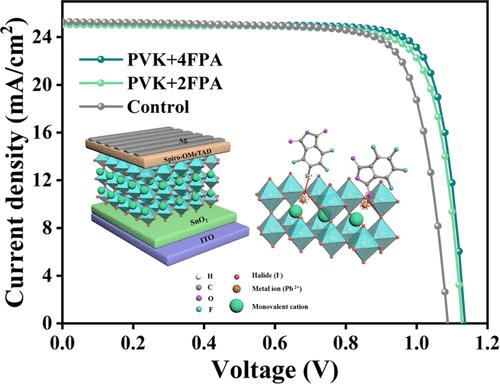氟化羰基添加剂优化钙钛矿太阳能电池性能
IF 8.2
2区 材料科学
Q1 MATERIALS SCIENCE, MULTIDISCIPLINARY
引用次数: 0
摘要
钙钛矿太阳能电池(PSCs)由于其载流子扩散长度长、带隙可调和光吸收系数高而成为一种有前途的光伏技术。然而,不稳定性仍然是它们商业化的一个重大障碍。本研究引入了两种不同氟原子数的羰基小分子添加剂:4,5-二氟邻苯酐(2FPA)和四氟邻苯酐(4FPA)。氟原子和羰基相互作用使钙钛矿结构中的缺陷钝化。4FPA与钙钛矿之间的强相互作用促进了晶体的缓慢生长和有效的缺陷钝化,显著抑制了非辐射复合,提高了载流子输运效率。因此,采用4FPA的psc的功率转换效率(PCE)从21.49%提高到23.21%。此外,添加剂中的氟原子与钙钛矿中的FA+相互作用形成强氢键,并与Pb2+形成配位键,从而增强了器件的稳定性。在未封装的条件下,在湿度为50%至60%的环境空气中大约1000小时后,4FPA装置保持其初始效率的87%。本文章由计算机程序翻译,如有差异,请以英文原文为准。

Performance Optimization of Perovskite Solar Cells via Fluorinated Carbonyl Additives
Perovskite solar cells (PSCs) have emerged as a promising photovoltaic technology due to their long carrier diffusion lengths, tunable bandgaps, and high light absorption coefficients. However, instability remains a significant barrier to their commercialization. In this study, we introduce two carbonyl small molecule additives with varying fluorine atom counts: 4,5-difluoro-phthalic anhydride (2FPA) and tetrafluorophthalic anhydride (4FPA). The fluorine atoms and carbonyl groups interact to passivate defects in the perovskite structure. The strong interaction between 4FPA and the perovskite facilitates slow crystal growth and effective defect passivation, significantly suppressing nonradiative recombination and enhancing carrier transport efficiency. Consequently, the power conversion efficiency (PCE) of PSCs incorporating 4FPA has improved from 21.49 to 23.21%. Additionally, the fluorine atoms in the additive interact with FA+ in the perovskite to form strong hydrogen bonds and coordinate bonds with Pb2+, thereby enhancing device stability. In unencapsulated conditions, after approximately 1000 h in ambient air with 50 to 60% humidity, the 4FPA device retains 87% of its initial efficiency.
求助全文
通过发布文献求助,成功后即可免费获取论文全文。
去求助
来源期刊

ACS Applied Materials & Interfaces
工程技术-材料科学:综合
CiteScore
16.00
自引率
6.30%
发文量
4978
审稿时长
1.8 months
期刊介绍:
ACS Applied Materials & Interfaces is a leading interdisciplinary journal that brings together chemists, engineers, physicists, and biologists to explore the development and utilization of newly-discovered materials and interfacial processes for specific applications. Our journal has experienced remarkable growth since its establishment in 2009, both in terms of the number of articles published and the impact of the research showcased. We are proud to foster a truly global community, with the majority of published articles originating from outside the United States, reflecting the rapid growth of applied research worldwide.
 求助内容:
求助内容: 应助结果提醒方式:
应助结果提醒方式:


